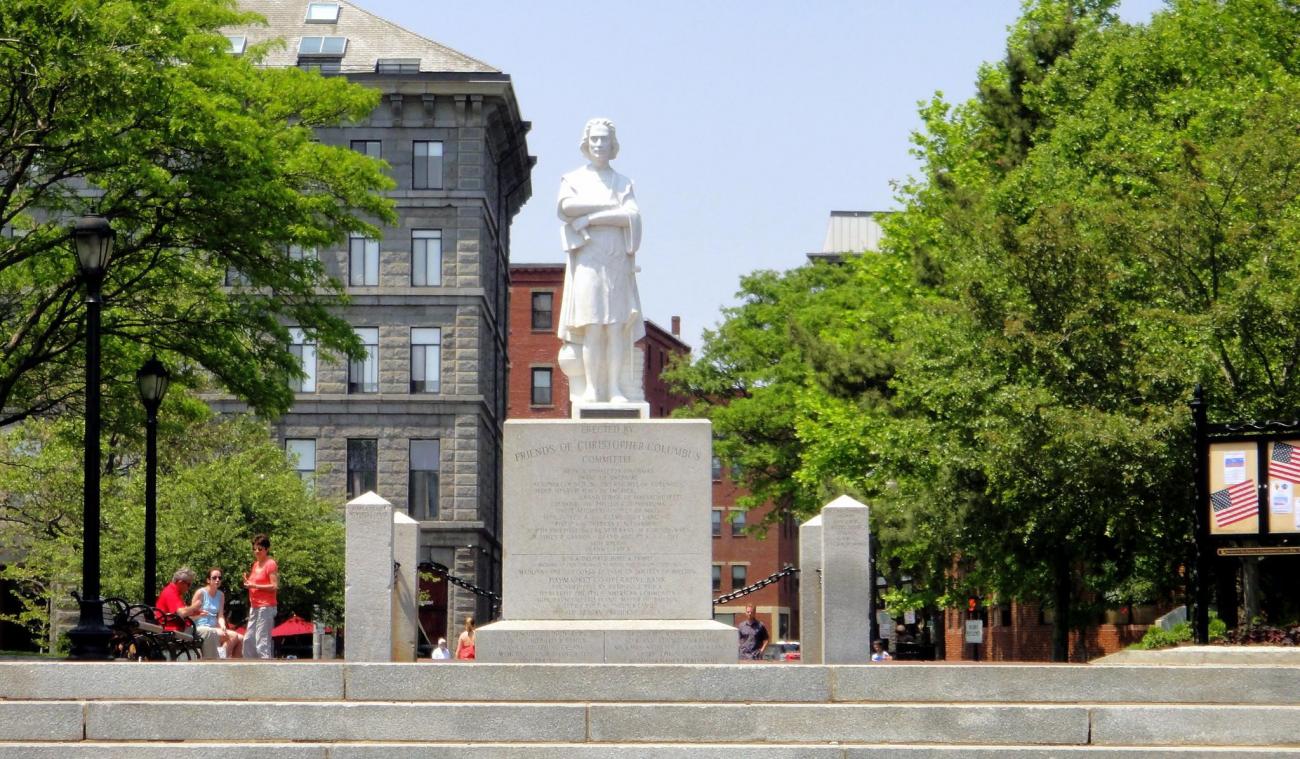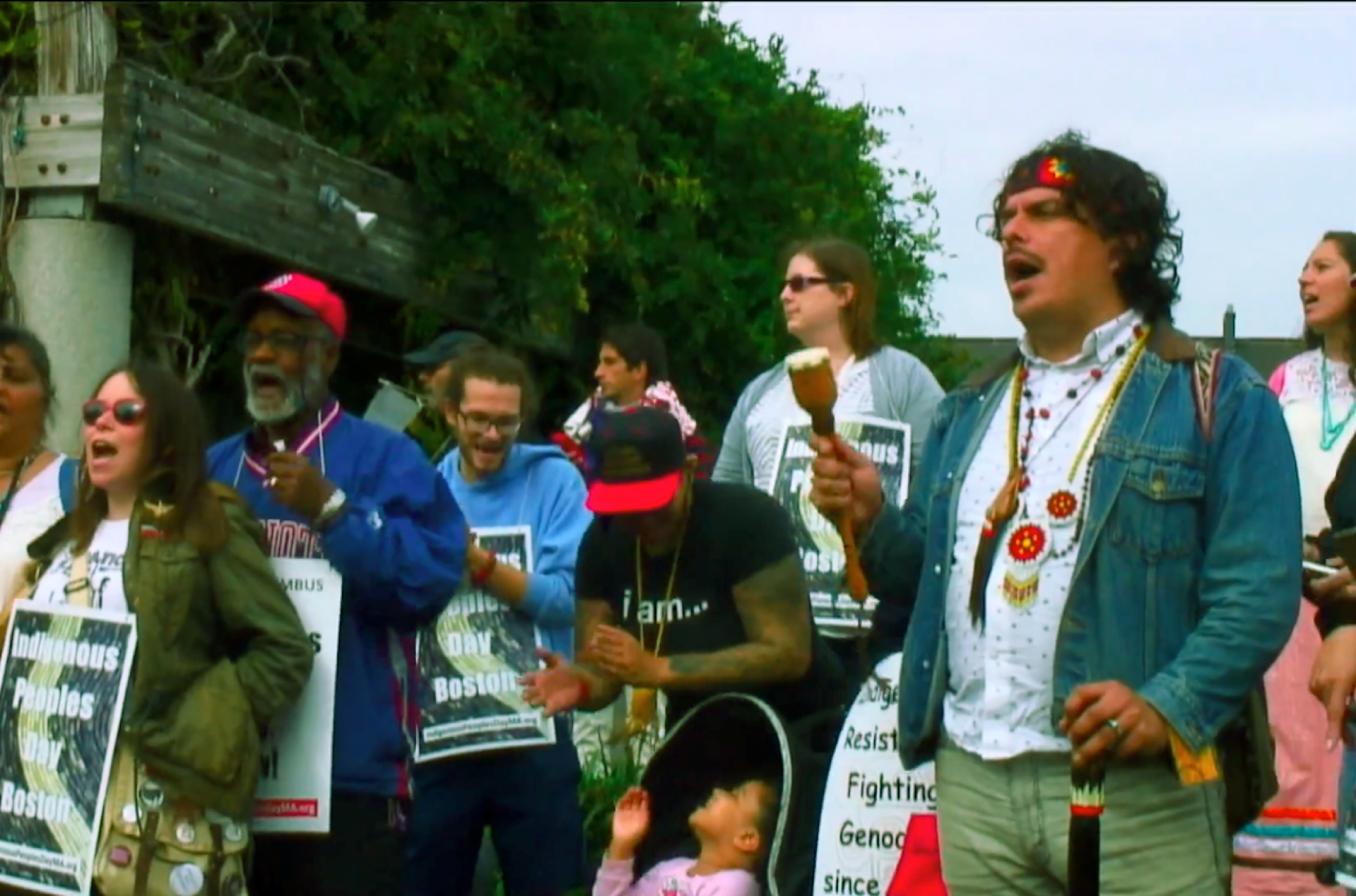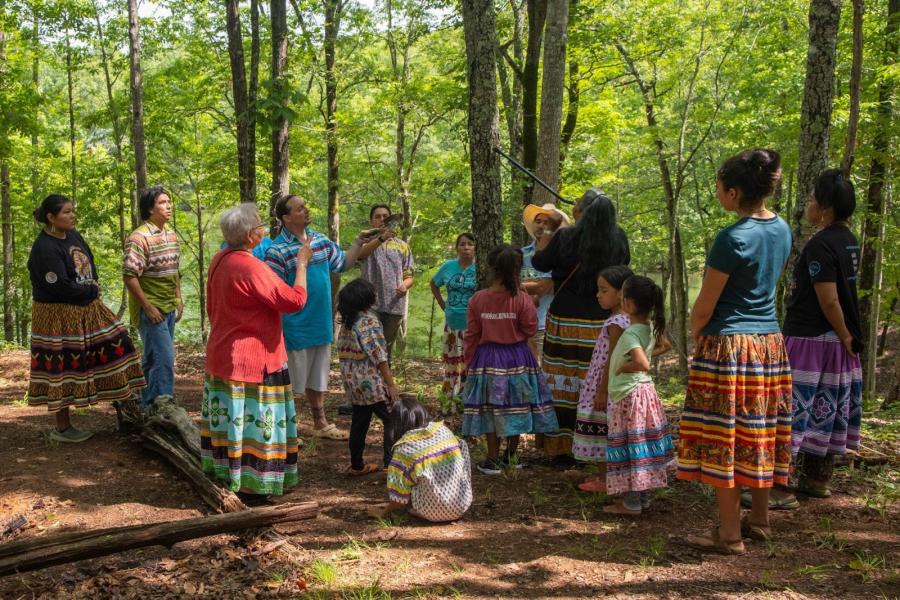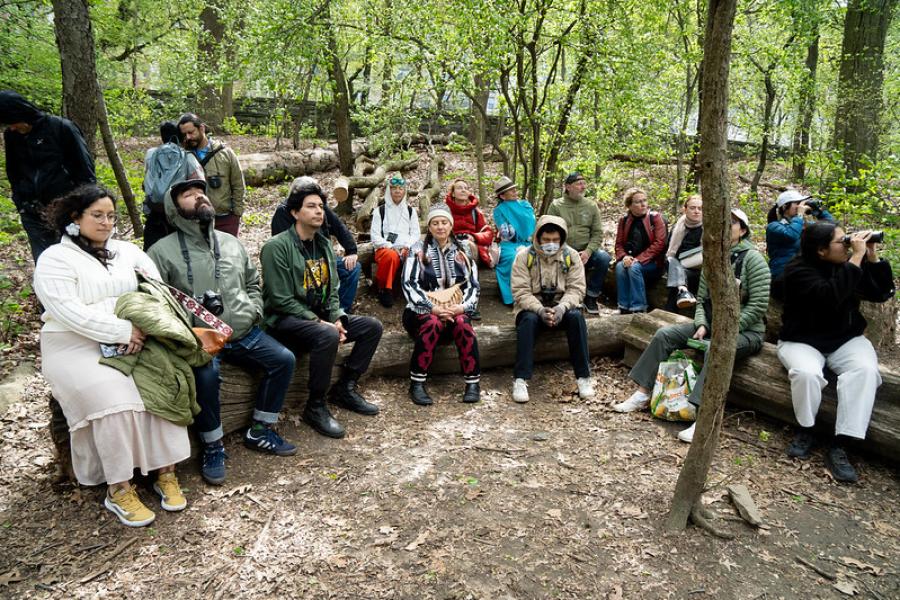
The Christopher Columbus statue in Waterfront Park, photograph by Matt Kieffer.
By Phillippa Pitts
This article was researched and written by Phillippa Pitts, a PhD student in History of Art and Architecture at Boston University, as a joint-initiative between Cultural Survival, the Boston-based activist group Italian-Americans for Indigenous Peoples Day, and United American Indians of New England / IndigenousPeoplesDayMA.org.
After 41 years in existence and almost as many years under protest, the presence of a Christopher Columbus statue in Boston’s Waterfront Park is once again under official review. Following its temporary removal in June, Mayor Marty Walsh has called for an analysis of “the statue’s historic meaning” to decide whether or not the sculpture should return to the Park. What we need, however, is an analysis of all the pasts, presents, and futures which coalesce around this statue and a conversation about the ongoing harm that this monument—and those like it—cause today.
“Colonial mythology is everywhere, enshrined in our schools, our laws, and in our public places,” says Erin Genia (Sisseton-Wahpeton Dakota), an artist in residence for the city of Boston. “We can no longer deflect responsibility for these transgressions into the past, because colonial mechanisms persist in harming Indigenous people and people of color everyday. These mechanisms occur openly, in public space, for all to see, creating a population that has been desensitized to its legacy. It’s time to confront these myths.”
The Creation and Re-creation of Waterfront Park
The land which is now known as Waterfront Park has taken many forms and possessed many meanings. Not so many years ago, Massachusetts Bay was an abundant estuary ecosystem, with a rare fresh spring, thriving salt marshes, and sprawling tidal flats. Today, the shape of the Shawmut peninsula has been entirely transformed. Massive 19th-century landfill enterprises converted the city-polluted flats into today’s South End, Back Bay, and Fenway. Well into the 20th century, the small stretch of harbor-facing land upon which Waterfront Park sits was a bustling mercantile wharf and, until the completion of the Big Dig, it was contiguous with a roaring interstate highway. All this land remains the ancestral territory of the Massachusett Nation.
Waterfront Park, which opened in 1976 on the United States’ bicentennial, was intended to rejuvenate the industrialized city center by affording a safe, public space for all Bostonians to enjoy the ocean view. The original design, which honored the site’s maritime past, has been adapted and modified repeatedly over the years. In fact, on a daily basis Waterfront Park is used in scores of different ways: an open-air movie theater, an outdoor preschool, an exercise venue, and an ever-changing public garden.
Within that historic context, the addition of Christopher Columbus’ name and statue to the park in 1979 is just one very recent and contentious moment. The park’s appearance today is only one iteration among hundreds—past, present, and future.

An aerial view of Waterfront park, photograph by Glenn Beltz.
Yet, as art historian Kirk Savage wrote, statues have “a curious power to erase their own political origins and become sacrosanct, a power that is still evident today whenever people rise to defend monuments from change or attack.” The notion that monuments preserve some universally shared truth or civic feeling is a fiction that their architects worked hard to produce, obscuring their individual motives behind a smokescreen of carved sponsor and supporter names, like those which form the base of this statue.
The Myth of Columbus
A great deal of ink has been spilled on the instigator of this particular statue project, Arthur Stivaletta. Some focus on his skill as a community organizer, others on his anti-communist, anti-Muslim, and pro-Vietnam war lobbying, as well as his local work against the desegregation of Boston’s schools in the 1970s. Recently, The 1492 Project, an anonymous group of Boston-based activist historians, have uncovered an astounding paper trail of condemnatory evidence about the small group responsible for the Columbus statue’s installation. Their work raises important questions about who the “Friends of Columbus” listed on the statues’ base were; how unpopular the “popular” support for this monument was; and what connections this project has to the histories of race, class, and quid pro quo corruption in Boston in the late 1970s.
Today, Stivaletta’s rhetorical framing of Columbus as the first immigrant, the first missionary, and the first entrepreneur is carried on by organizations such as the Italian American Alliance. At best, these honorifics glorify a worldview that continues to ignore the existence of Native Peoples, past and present. The mythologized “freedom” and “economic opportunity” that this narrative espouses came at the genocidal expense of millions of Indigenous people through an ongoing legacy of atrocities that began with colonization: disease, displacement, enslavement, rape, forced conversion, and death. Within just a generation of Columbus’ landing, an estimated 50 million Indigenous people perished. That’s three and a half times the total population of New England today.
Moreover, Columbus did not merely “open the door” to settlement and colonization, as many claim. Columbus himself was a genocidal slave trader who perpetrated an abhorrent list of violent crimes first against the Indigenous Taino people on the island of Ayiti (Hispaniola) and subsequently across the Caribbean. The pearls, gold, exotic animals, and enslaved Indigenous people brought back to Spain to repay Columbus’ investors were extracted through a brutal regime of murder, brutal disfiguration, torture, sexual slavery, rape, and mass enslavement, all justified by colonial greed and hidden behind a rhetorical smokescreen of eternal salvation. Columbus cannot be salvaged by claims that he was a man of his time: even his contemporaries condemned the atrocities he committed.
The sanitized statue in Waterfront Park makes none of this visible. Columbus stands alone, holding an empty map of the supposedly-empty world he ‘discovered’. The pile of bodies at his feet are not to be shown, in the hopes that they will not be remembered.
But they are remembered; by Indigenous People across the Americas and native to the lands where Waterfront Park is now situated. “For us, Columbus is a constant reminder that we’ve been colonized, a reminder of the brutality that happened here. It’s propaganda, centered around an individual who committed atrocities,” explains Faries Gray, Sagamore of the Massachusett Tribe.
A Monument to White Supremacy
Yet, even with the careful erasure of Columbus’ crimes, this statue is still not a monument to Italian Americans’ contributions to their country. It is a document of their exclusion.
As historians Matthew Jacobson, Danielle Battisti, Jennifer Guglielmo, Salvatore Salerno, and others have well documented, Italian Americans’ racial status oscillated over the course of the 19th and 20th centuries. Whiteness—as both a social and a legal category—was a closely guarded privilege doled out by scientists, academics, government officials, politicians, journalists, and immigration officers. Successive waves of European immigrants were classified into a fluid hierarchy of relative whiteness which determined their access to work, housing, legal protection, and economic opportunity. Nationalities like Irish, Greek, and Italian became racial groups in the United States, ones subsequently ranked lower than English, French, and German on a ladder of relative “whiteness.” Dark-skinned, southern Sicilians were often coded as Black both in Italy and in the Americas, subject to racially-motivated vile slurs and violent acts.
Celebrating Christopher Columbus offered one way of moving up this ladder. It allowed Italian Americans to author their way into American mythology not as new immigrants but as founding fathers, with all the paternalistic rights that such a status implied. It was a narrative that served American goals more broadly: it offered a story of an ascendant New World completely un-indebted to British forefathers. Thus, the momentum around Columbus continued from the naming of the District of Columbia in 1791, to the World Columbian Exposition in 1893, to the Columbus craze of the nation’s Bicentennial Celebrations in 1976. For Italian Americans, a place within this nation-building narrative was as valuable on the first Columbus Day in 1892—declared as an political olive branch after the murder of 11 Italian immigrants in New Orleans—as it was in 1934 when Italian Americans had become a significant enough voting block to push for federal recognition of the holiday, as it was in 1979 when this particular statue was included in the efforts to establish a positive identity for the then majority-Italian enclave in Boston’s North End.
But this statue does not celebrate the myriad contributions of Italian American philosophers, scientists, artists, and veterans. It does not honor Italian Americans’ work in overturning racist immigration policies in 1965 or remember Italian American labor activists unjustly executed for their work on behalf of immigrant and African-American citizens. What this statue perpetuates is a politically expedient myth: a flawed tool forged for a deeply broken world.
The Whiteness of Marble
For those who look critically, this battle for whiteness can be read on the very surface of the Waterfront Park statue. In one of the greatest of ironies, the 19th century employed Greek and Italian heritage to create the very racial hierarchy that Greeks and Italians then had to fight their way through.
Sculpture was foundational to racialized science in many ways, as numerous scholars have nuanced. For example , nineteenth-century scientists used the heads and features of Greek and Roman statues—not people—to define an ideal, quantifiable, empirical whiteness against which all other races could be measured. Plaster casts taken from the heads of 72 Native men imprisoned in Fort Marion, FL, are still held in the collections of Harvard’s Peabody Museum of Anthropology and Ethnography, where they were sent in the late 19th century to be used as evidence of Native peoples’ racial inferiority. The Penn Museum has only just removed the Morton crania collection—a euphemistic way to describe the exhumed skulls of 53 enslaved people marked, measured, and displayed to “prove” the intellectual and physical superiority of German and English ancestry—from a basement classroom.

Detail of the Waterfront Park Christopher Columbus, photograph by David Ohmer.
This is the history that is built into Boston’s Columbus statue. If race is a discourse of the body, then a body is the best weapon with which to argue it. The unadulterated, luminous whiteness of the sculpture’s prized Carrara marble surface—extracted and refined by sweatshop labor—is not an accident of history or taste. As many scholars have articulated, Carrara marble’s ubiquity in European and Euro-American public monuments was a conscious, ideologically motivated decision. Despite the known fact that Greek and Roman sculptures were painted in a riot of bright colors, nineteenth- and early twentieth-century cultural authorities abhorred polychrome (non-white) sculptures, whether they were painted, pigmented, or assembled of mixed stones. As art historian Charmaine Nelson writes, “Polychromy was associated with everything the neoclassical was not… if the (neo)classical body was contained, controlled, pure, restrained and noble, the polychromed was unruly, diseased, sensuous and immoral.” Color became associated with the foreign, feminine, vulgar, Queer, Black and Brown. In other words, stone was racialized with the same harmful stereotypes that were applied to people. Marble whiteness was a way to claim racial whiteness.
Looking at this portrayal of Columbus—for whom no accurate likeness survives—the coding beneath his construction is barely veiled. He reads like a schema for quintessential whiteness: a thin straight nose, high forehead, oval face, and sweeping smooth hair. Contrast this portrayal with the stereotypical features—dark skinned, with kinky hair—assigned to Italian Americans, whose geographic origins were close enough to Africa to place them close to Blackness. Perhaps a more skilled portrayal might have cloaked this claim with imagined specifics, or attempted some kind of verism with articulated muscles, tendons, and veins. Not this sculpture. Its point can be read quite clearly.
What we see in this statue is an image of the United States at its worst: an image motivated by race-based exclusion, located in violent pseudo-science, accompanied by the celebration of genocide and loss. What this statue honors is an instance of Italian Americans fighting their way up a racial hierarchy. Wouldn’t we rather celebrate the many other examples of Italian Americans fighting their way past it?
Celebration vs. Memory
"There has always been the feeling that Italian Americans all feel the same way about Columbus," said Heather Leavell, one of the founders of the Boston-based group Italian Americans for Indigenous Peoples' Day. This is not true, as the organization’s website makes clear with its firm statement, “We believe that any association with Christopher Columbus diminishes our culture and does not honor the struggles of our ancestors who, throughout the late 19th and much of the 20th century, endured profound discrimination, economic exploitation, and racial violence… We feel a responsibility to use the platform our ancestors have given us to ensure that we are not repeating the same patterns of discrimination that they endured.”
The ways in which the United States has required people to perform whiteness—legally, socially, and culturally—in order to access voting, housing, employment, and even basic liberty is not something that should be celebrated. Do we parade Nazi flags or set up statues to Pol Pot? No. But neither do we erase or forget them. We learn about these events in order to honor those who suffered and ensure such acts will never be repeated. How does this statue do either—except possibly when activated by a bucket of blood-red paint?
Yet, as that red paint drips down over a base covered with the names of Italian Americans, it sets up a false dichotomy. It implies that there is choice to be made between either celebrating genocide or dishonoring the many contributions of Italian Americans to this country and Italians to the world. This is a fiction produced by the statue, not a truth in the world. There can be both Italian American heritage month (October, in Massachusetts) and an Indigenous Peoples’ Day celebrated on the second Monday of the month. In a Waterfront Park that welcomes everyone, there could be monuments to many Italian heroes and heroines without celebrating the loss of millions of Indigenous lives. Columbus is the problem, not the answer. Gray, of the Massachusett Tribe, suggests that a dialogue could take place to determine how to honor Italian heritage at that site in a way that is palatable to all. “There are so many Italian people throughout history who are a better fit to honor instead of Columbus. We understand how Italian Americans were treated when they first got here… and we all live here now… but we shouldn’t celebrate anyone throughout history that has committed acts of violence against anyone.”
Cities around the country—and across this hemisphere—are employing precisely this logic. In Buffalo, an Italian American heritage group voluntarily removed their Columbus statue, with plans to replace it with one which better honors Italian heritage. In Baltimore, the city declined to intervene as protestors relocated a statue of Columbus from Little Italy to the Inner Harbor. Their mayor, Bernard Young, firmly stated that the city’s resources should be dedicated to protecting lives, not statues. The city of Columbus, OH, is even reconsidering its own name, having removed its Columbus statue and dispensed with Columbus Day as a holiday. “For many people in our community, the statue represents patriarchy, oppression and divisiveness. That does not represent our great city, and we will no longer live in the shadow of our ugly past,” said Columbus mayor Andrew Ginther. “Now is the right time to replace this statue with artwork that demonstrates our enduring fight to end racism and celebrate the themes of diversity and inclusion.”
“There are some people who won’t listen, who refuse to learn,” says Mahtowin Munro (Lakota), a co-leader of the United American Indians of New England. “I don’t think that their feelings about loving Columbus should be privileged over the genuine damage that we feel as Indigenous people by going generation after generation where Columbus is held up as some kind of hero. And especially the damage that it does to our children.”
Contextualization Is Not An Appropriate Response
Often, calls for the removal of Columbus statues have prompted counter-proposals to contextualize the objects where they are. Such plans ostensibly mitigate the harm these sculptures do by transforming them into spaces for education, conversation, and dialogue using the entire museological toolkit of programming, interpretive signage, and audio tours. Regardless of whether these gestures would succeed in any given space, none of them could undo the physical and spatial power of this statue’s placement within this part of the urban built environment. Waterfront Park is not the appropriate site for this conversation.
Boston is a city which has almost entirely been turned over to Anglo-American ideas of enclosure, private property, and ecologically catastrophic “improvement.” There are few spaces remaining which are left open to communal use: to celebrate water, land, air, and sea. Within the settler legal framework, the land formally maintained by tribes in the Northeast has been eroded into near-nonexistence by centuries of seizure, sale, and fraud. However, the Northeast remains Native space: its land, rivers, hills, marshes, and harbors. Where Boston’s settler cultures use plaques, sculptures, and fences to carve out historic spaces and materialize a narrative of colonial expansion and Indigenous disappearance, Native Peoples locate their histories in the place itself: in rocks, hills, trees, water, and land.

View of Waterfront Park from the harbor, photographed by James O'Keefe.
These histories do not end at the modern borders of modern cities. Since its creation, Waterfront Park has been an important—and often painful—memoryscape for Indigenous people. It looks out on the Harbor Islands, which were, for centuries, a seasonal home with plentiful food, before becoming a place of mass internment and death during King Philips’ War. Every year, the park is the terminus of the Boston Indigenous Peoples’ Day March, which celebrates the resiliency, survival, and power of Native people. To place a monument to white supremacy on a pedestal, presiding over that space, is an act that no contextualization can undo.
“This park should belong to the people of Boston and be a public place that feels welcoming to everyone in Boston, ” says Munro. At the moment however, Munro says, “It’s a park dedicated to white supremacy; it’s a park dedicated to Indigenous genocide… the messaging is clear with the statue here that this is an area where white people are welcome, but where our people are not welcome. So we’ve been asking for years that this statue come down and that Columbus no longer be celebrated.”

Crowds gathered in protest in front of the Columbus statue in Waterfront Park during the 2018 Indigenous Peoples’ Day March. Image courtesy of Indigenous Peoples March.
“It’s a shame that it had to come to the defacement of a statue to get attention. That our people have to cry out to get listened to. That says a lot about the society we’re in,” laments Gray. “If they put the statue back up, it’s going to continue. They need to take it down and move on.”
--
Update and how to take action:
The Boston Arts Commission recently delayed a vote on whether to permanently remove the statue, and a future date for further hearings is to be announced.
Make your voice heard on the removal of the Columbus from Boston’s Waterfront Park and across the Commonwealth
- Submit testimony to the Boston Arts Commission here
- Sign a petition to the Mayor of Boston here
- Support the Massachusetts Indigenous Legislative Agenda by taking action here
- Take action to change Columbus Day to Indigenous Peoples Day at IndigenousPeoplesDayMA.org



